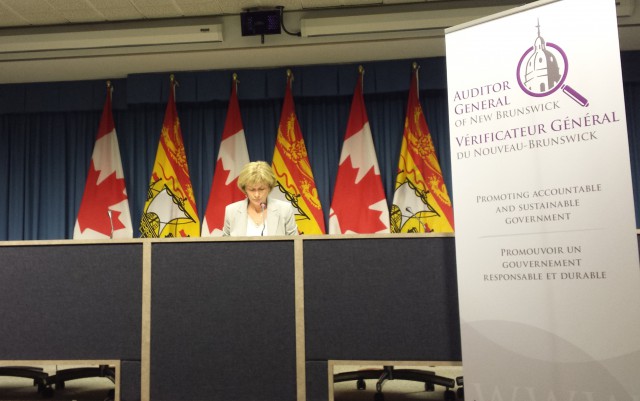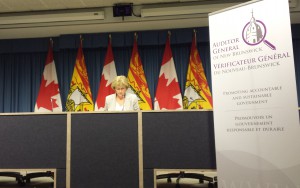On Tuesday, June 23, Auditor General Kim MacPherson released Volume II of her 2015 Auditor General Report, which included two chapters related to forest management. Read the full report, or check out our response.
Below are some highlights and key findings from the report as well as quotable quotes pulled from the document and the auditor general’s statements to MLAs in the legislature on Tuesday.
Quotes from Auditor General Kim MacPherson:
“There is an apparent bias to support industry and economic development for both the Crown and private silviculture programs.”
“You can see clearcut is running consistently around 80% whereas in the area of selective or partial cut, there is a decline from 20% to roughly 10% in more recent years.”
“The bottom line shows that there is a forest management deficit in the range here showing $7 to $10 million. This essentially shows there is no direct financial benefit to the province’s finances from year to year.”
“We further concluded the department has not acquired silviculture services with due regard for economy and efficiency.”
“We found the forest management manual, the standards document governing licensee conduct on Crown land, was an interim document from 2004 — so it was over 10 years ago — and it had never been formalized, as the department could not get industry acceptance.”
“In our review of silviculture practices and standards, we found them to target high-value softwood regeneration, primarily spruce and pine. According to the department, this is because industrial users predominantly use softwood in the mills. Our documentation review found numerous references and recommendations related to preserving the natural biodiversity of the forest and how different harvest methods influence the type of forest that grows back.
“As a result of our extensive documentation review of the various reports and studies commissioned by and conducted by the department, we note that many of the recommendations and findings in these reports have not been adopted or responded to by the department.”
Highlights from report:
On the value of our forest…
- New Brunswick forests have been the mainstay of the provincial economy for over a century, not only through forestry but also tourism, recreation, hunting and fishing. Our forests are an invaluable social, economic and environmental contributor to the quality of life enjoyed in New Brunswick and are our legacy for future generations. New Brunswick forests are one of our most valuable assets and they are critical to the current and future prosperity of the Province. It is important that they be managed and cared for properly. (Chapter 3, pg. 124)
- Sustainable forest management means balancing the various socio-economic and environmental values and other nontimber objectives with timber objectives. “It requires an adaptive management approach that recognizes a forest’s potential to sustain a range of values to users and strives to find the best balance of uses based on relative benefit and impact.” (Chapter 3, pg. 125)
- Forests are a cornerstone of the economic, environmental, and social foundation in New Brunswick. Forestry is a pillar of the New Brunswick economy. (Chapter 3, pg. 111)
- The Crown forest is also our legacy to future generations to ensure they can benefit from a strong forestry sector and can continue to enjoy the natural beauty and diversity of our forests. (Chapter 3, pg. 111)
- A survey undertaken in 2007 found “94% of NB residents visit forests during the year” and “over 95% of respondents participate in forest-related activities.” Clearly New Brunswick residents utilize and value forests of the Province. The survey found “environmental aspects remain the two most important values.” The two environmental aspects were: protection of water, air, and soils, and valuing forest as habitat for animal and plant life. Economic wealth and jobs ranked third. (Chapter 3, pg. 112)
On silviculture program…
- The Province has spent $125 million over the last five fiscal years with an additional $22 million spent on the private land silviculture program for a total investment in our New Brunswick Forests over the last five years of approximately $29 million per year. (Chapter 3, pg. 129)
- Report concluded the silviculture program provides “no direct benefit to province’s finances.” (Chapter 3, pg. 149) In responding to this, department officials noted there are indirect benefits to the program, such as job creation, however MacPherson said they could not provide evidence to show whether the number of jobs it created was worth the average of $29-million spent on the program each year.
- During our audit period of 2009 to 2014, the Department fell short in fulfilling some of its related management and oversight responsibilities. This includes not updating the forest management plans and agreements; failing to enforce compliance with treatment standards and not completing licensee performance evaluations, in addition to not keeping the public informed on the state of the Province’s forests and the impact of the Department’s silviculture activities. (Chapter 3, pg. 115)
- There was a shortage of current summarized forestry data at the provincial level with which decision makers could evaluate alternatives and make informed decisions. (Chapter 3, pg. 116)
- We found the Department does not provide adequate accountability information to the Legislative Assembly and the public relating to the effectiveness of the program. We also noted a lack of clear financial accountability for how the funds are being spent, and what benefits will accrue to ensure adequate future timber supply. (Chapter 3, pg. 116)
- We found silviculture processes and decisions were driven by an apparent Department objective to support industry and economic development. For example: • standards have been changed to give licensees more operational flexibility such as relaxing the planting standards; • financial and process concessions have been granted to a licensee for which deficiencies were found during compliance monitoring; and • strategic direction has been delayed to allow government to find ways to help industry be more competitive. (Chapter 3, 9g. 117)
- The Department has commissioned several reports and studies over the last ten years. Many of the recommendations made in these reports have not been adopted or responded to by the Department. (Chapter 3, pg. 117)
- Average silviculture spending over the last five years by the Department of Natural Resources (the Department) has been approximately $29 million. It is one of the largest expenditures of the Forest Management branch. Crown timber license management and silviculture are the two most significant cost components, which offset earning royalty revenue from Crown Timber. (Chapter 3, pg. 115)
- We believe it is important to the Legislative Assembly and the general public to know how the Department is safeguarding and overseeing the renewal of one of our most valuable natural resources. (Chapter 3, pg. 115)
- We found the main standards document, the Forest Management Manual for New Brunswick Crown Land, to be an interim, out of date document. Since last published in 2004 it has been superseded by other policies, directives and generally accepted practices. Lack of clear operational compliance standards makes monitoring more difficult and increases the risk of non-compliance. (Chapter 3, pg. 116)


